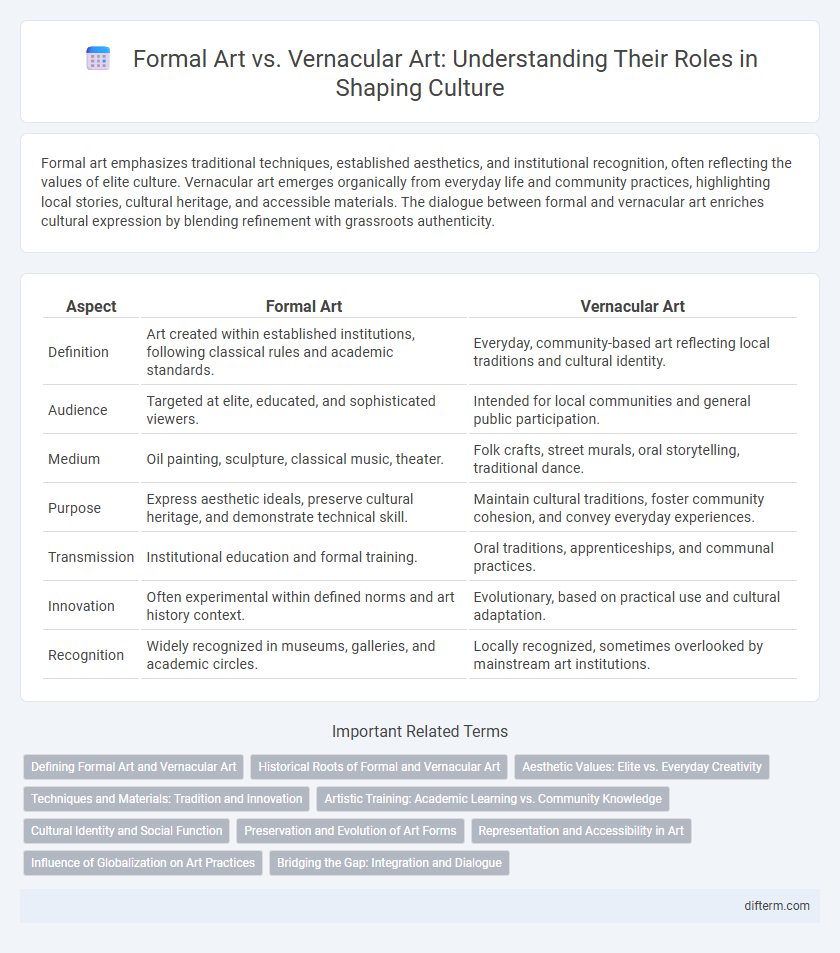Formal art emphasizes traditional techniques, established aesthetics, and institutional recognition, often reflecting the values of elite culture. Vernacular art emerges organically from everyday life and community practices, highlighting local stories, cultural heritage, and accessible materials. The dialogue between formal and vernacular art enriches cultural expression by blending refinement with grassroots authenticity.
Table of Comparison
| Aspect | Formal Art | Vernacular Art |
|---|---|---|
| Definition | Art created within established institutions, following classical rules and academic standards. | Everyday, community-based art reflecting local traditions and cultural identity. |
| Audience | Targeted at elite, educated, and sophisticated viewers. | Intended for local communities and general public participation. |
| Medium | Oil painting, sculpture, classical music, theater. | Folk crafts, street murals, oral storytelling, traditional dance. |
| Purpose | Express aesthetic ideals, preserve cultural heritage, and demonstrate technical skill. | Maintain cultural traditions, foster community cohesion, and convey everyday experiences. |
| Transmission | Institutional education and formal training. | Oral traditions, apprenticeships, and communal practices. |
| Innovation | Often experimental within defined norms and art history context. | Evolutionary, based on practical use and cultural adaptation. |
| Recognition | Widely recognized in museums, galleries, and academic circles. | Locally recognized, sometimes overlooked by mainstream art institutions. |
Defining Formal Art and Vernacular Art
Formal art refers to works created by trained artists adhering to established aesthetic principles and recognized art institutions, often exhibited in galleries or museums. Vernacular art encompasses everyday creative expressions rooted in local traditions and communities, typically crafted by self-taught individuals for functional or cultural purposes. The distinction lies in formal art's emphasis on refinement and theoretical frameworks versus vernacular art's connection to cultural identity and practical use.
Historical Roots of Formal and Vernacular Art
Formal art traces its historical roots to classical traditions supported by academic institutions, embodying refined techniques and established aesthetics often associated with elite cultural expressions. Vernacular art originates from everyday life and local communities, reflecting indigenous materials, folk practices, and oral histories passed down through generations. The evolution of both art forms highlights the diverse modes of cultural identity and social function embedded in artistic expressions across history.
Aesthetic Values: Elite vs. Everyday Creativity
Formal art often embodies elite aesthetic values through meticulously crafted techniques and adherence to established standards, reflecting cultural prestige and historical significance. Vernacular art, meanwhile, highlights everyday creativity by incorporating local traditions, materials, and community narratives, fostering accessibility and cultural identity. These contrasting aesthetics reveal distinct perspectives on beauty and artistic purpose within cultural expressions.
Techniques and Materials: Tradition and Innovation
Formal art often employs classical techniques and materials such as oil painting on canvas or marble carving, adhering to long-established traditions that emphasize precision and refinement. Vernacular art, by contrast, incorporates locally sourced materials and spontaneous methods, reflecting cultural innovation and everyday life. This dynamic interplay highlights how tradition and innovation coexist, with formal art preserving heritage and vernacular art adapting to evolving social contexts.
Artistic Training: Academic Learning vs. Community Knowledge
Formal art emphasizes academic learning through structured institutions, where artists undergo rigorous training in techniques, art history, and theory. Vernacular art is rooted in community knowledge, passed down informally within cultural or social groups, reflecting collective experiences and traditional practices. This contrast highlights how formal education shapes technical proficiency, while community-based learning fosters cultural authenticity and localized expression.
Cultural Identity and Social Function
Formal art often reflects dominant cultural narratives and is associated with institutional settings, reinforcing established identities through recognized symbols and styles. Vernacular art thrives within local communities, embodying grassroots cultural identity and serving practical social functions such as storytelling, ritual, and communal cohesion. The interplay between formal and vernacular art highlights how cultural identity is both preserved and transformed within social structures.
Preservation and Evolution of Art Forms
Formal art, often preserved in museums and academic institutions, relies on established techniques and historical continuity to maintain its legacy. Vernacular art evolves through community practices and everyday expressions, reflecting cultural shifts and adapting to contemporary influences. Preservation efforts for vernacular art emphasize documentation and living transmission, while formal art benefits from institutional conservation and scholarly research.
Representation and Accessibility in Art
Formal art often emphasizes traditional techniques and elite representation, focusing on established aesthetic standards and cultural canons. Vernacular art prioritizes accessibility and reflects everyday experiences, allowing marginalized communities to express identity through informal or local mediums. This contrast highlights how representation in art shapes cultural inclusivity and democratizes creative expression.
Influence of Globalization on Art Practices
Globalization has facilitated cross-cultural exchanges, leading to the blending of formal art traditions with vernacular art practices worldwide. Formal art institutions increasingly incorporate diverse local styles, while vernacular art adapts new materials and technologies from global networks. This dynamic interaction reshapes artistic expressions, reflecting interconnected identities and cultural hybridity.
Bridging the Gap: Integration and Dialogue
Bridging the gap between formal art and vernacular art fosters a dynamic cultural dialogue that enriches both spheres by blending institutional techniques with traditional community expressions. This integration promotes inclusivity and broadens the definition of artistic value, highlighting diverse narratives often overlooked in mainstream art. Collaborative exhibitions, community workshops, and cross-disciplinary projects serve as effective platforms to merge these art forms, encouraging mutual respect and innovation.
formal art vs vernacular art Infographic

 difterm.com
difterm.com